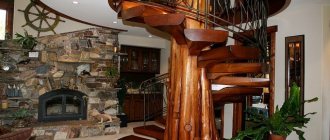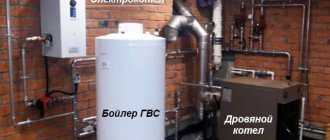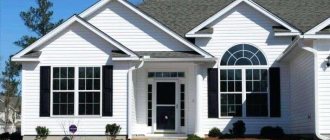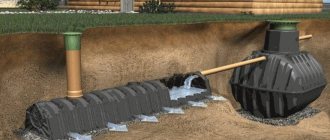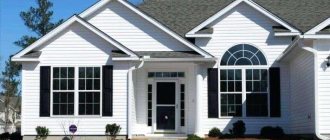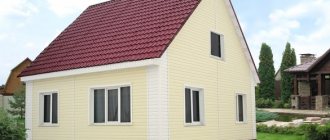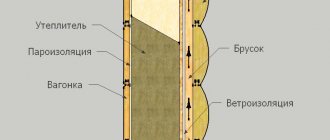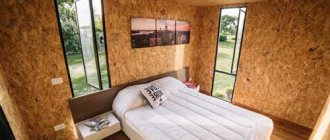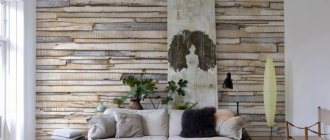Among compatriots, and throughout the world, today, facing the facade with siding is a fairly common option. The materials used for its manufacture are varied, and there are also a lot of options for designing facades using it. You can see for yourself how buildings look by looking at our selection of photos of façade decoration with siding.
Siding for facades of private houses made of plastic
This material is very popular. Its main advantage is cost. It is also durable, resistant to temperature changes, resistant to corrosion, and easy to install.
The disadvantage of this material is that if the integrity of one sheet is damaged, the entire wall of the façade will have to be replaced. It also doesn't retain heat very well. For this reason, when installing plastic siding, the addition of insulating material is required.
Plastic facade siding for exterior decoration of the house
There are two types of plastic siding: vinyl and acrylic. The first is made from PVC with the addition of additives that improve its properties.
Vinyl siding. (photo No. 6)
Acrylic siding differs in composition and appearance: special ASA polymers give it a glossy shine. Such panels are more resistant to heat and UV radiation, so they do not fade in the sun. Vinyl, on the contrary, have increased resistance to low temperatures.
The peculiarity of plastic siding is its susceptibility to thermal expansion and contraction. If the panels are installed correctly, with the necessary technological gaps, then such an expansion is completely harmless and will not harm the integrity of the facade. But if the installation technology is broken, the siding may become deformed due to temperature changes.
Acrylic siding. (photo No. 7)
Advantages of plastic siding:
- ➠ It's lightweight. Can even be used on frame buildings.
- ➠ Does not rot or rust.
- ➠ Not afraid of moisture and water.
- ➠ Does not support combustion. Without exposure to a direct fire source, the panels themselves extinguish.
- ➠ Does not require maintenance - just wash with running water from a hose.
- ➠ Does not deform due to changes in temperature and humidity.
- ➠ Easy to cut. This does not require special equipment; you can use ordinary home tools.
!
Plastic siding is the lightest of these. It is easy to cut and install. It is suitable for any house, even frame or old.
Cons of plastic siding:
- ➠ This is not a natural material.
- ➠ Low-quality panels can release toxic substances when burned.
A variety of shapes, colors and textures allows everyone to find their own option. Most often, plastic siding for the exterior of a house imitates a wooden facade. But panels with the texture of stone and brick are also made from plastic. In this case, a different technology is used, and the panels have a different shape, so we will put them in a separate group.
Facade cladding with metal siding
The most common design option for the façade of buildings is a combination of materials. For example, siding is combined with stone masonry, metal with wood, and the surface of the material is also combined with a textured and smooth surface.
The cladding of semicircular surfaces with metal panels, as well as various arches and other shapes with roundness, looks original.
When combining finishing materials for the façade of buildings, the main thing is to do everything in moderation so that everything fits together harmoniously. But as for the color scheme, you can think about it. After all, not a single shade of gray can surprise anyone for a long time!
Vinyl Trim Colors
For the convenience of choosing colors, it is divided into several groups:
- White and bright colors are more often used for edging. The main color of the house is pastel.
- Beige, sand and terracotta shades are suitable for the plinth, in combination with natural-colored panels.
- Pistachio, plum, banana colors are suitable for wall panels with a block-house profile.
Features and characteristics of fiber cement siding
Fiber cement siding is made from cement with the inclusion of cellulose fibers. The production process involves the use of high temperatures and drying chambers. The finished products are durable, flat, and resistant to temperature changes.
Cedral fiber cement siding
Fiber cement siding
Fiber cement siding is intended for cladding plinths, which is included in the category of facade work. This material can also be used for wall cladding. But it does not have as attractive an appearance as vinyl and metal. Therefore, it is not often used as a façade. However, they are often used to line the walls of garages, production and utility rooms.
Structured fiber cement siding
Cedral fiber cement siding is a man-made wood replacement
Installation of fiber cement siding is practically no different from similar work with metal and vinyl. The same requirements apply to the presence of lathing, steam and thermal insulation of walls. In Russia, three brands of fiber cement siding are most famous:
- Nichiha;
- Eternit;
- Latonit.
Fiber cement siding panels Eternit
Domestic production - Latonit. Nichiha is made in Japan, Eternit is made in Belgium. Russian products have a lower price with decent quality products.
Fiber cement panels Latonit on the facade of a private house
The cost of the panels depends on the type of protective coating used in their production. Basically, the design of fiber cement siding contains red, brown, and gray tones. Acrylic coated panels have a higher price. On average, it ranges from 600-650 rubles per unit.
Fiber cement painted siding panels LATONIT
Features and characteristics of metal siding
Metal siding is chosen for various reasons. But the main ones are the strength of the panels and components, frost resistance, moisture resistance, and aesthetically attractive appearance. The relative disadvantages of these products include the ability of the metal to heat up when exposed to cold. But this problem can be solved by using high-quality thermal insulation materials.
View of metal siding on the facade of a house
The most popular metal siding is made from thin sheets of galvanized steel. The outer side of such panels is coated with a special protective compound that prevents the formation of corrosion. The coating of the panels can withstand significant temperature changes: from -60°C to +80°C. The most popular panels with protection are made of pural (up to 50 microns), plastisol (up to 200 microns), and polyester (25 microns).
Metal siding for logs
Wood-look metal siding
In addition to steel, the market offers copper (oxidized or patinated) and aluminum siding. The latter is the least in demand, as it is a rather soft material that leaves scratches and dents.
Structure of vertical aluminum siding
When choosing metal siding, you must make sure in advance that the supporting base on which it will be installed is capable of supporting the fairly significant weight of this facing material. There is no need to worry about the service life of the panels: manufacturers guarantee at least 50 years of impeccable service.
What to look for when choosing metal siding
Having opted for metal siding, the buyer rarely thinks about the cost of additional elements that are necessary to give the facade a complete and attractive look. However, their price is only slightly lower than the cost of the panels. The number of required components is large. These are starting strips, finishing strips, cornice strips, soffits, window strips, external and internal corners.
Additional elements for metal siding
Without installing these components, it is impossible to make high-quality facade cladding. You can calculate the number of additional elements yourself or use the services of a point of sale. Each building and finishing materials store employs qualified specialists. Using computer programs, they will be able to accurately calculate the amount of material required for cladding a particular building.
Metal siding prices
Metal siding
What's special about siding?
The name “siding”, which has become very firmly established in our everyday life, was actually borrowed. It comes from the English language from the word side, which translates as “side”. In principle, this is logical, considering that it is mounted on the wall. It is designed to provide two functions at once:
- decorative;
- protective.
Regarding the first, siding boasts a wide selection of colors, as well as a variety of structural types. Siding is truly an excellent protective material that can protect insulation and the walls themselves from unpleasant weather conditions. Most types of siding are highly resistant to hail, strong winds and other physical impacts.
Siding is in many ways similar to clapboard for exterior trim. It consists of individual sheets that are mounted into a common structure. Siding is not a completely airtight material. Otherwise, the walls underneath would become unusable. That is why special ventilation holes are provided, which are necessary to ventilate moisture and condensation.
Some types of siding can last up to 50 years. It's a good investment for a finish that won't require much intervention. Most types of siding are very easy to maintain.
They are easy to wash with a washcloth and detergent or just a hose. The origins of the history of siding go back to Switzerland. The first mention of the material that was used to cover walls in this way appears more than two centuries ago. During this time, the method went through a series of modifications and transformations, becoming what we know it today.
Classification of siding by purpose
The material can be used for various purposes.
Wall
It is a finishing option used for cladding the facades of houses, cottages or other private and commercial buildings.
- According to the installation method, it is divided into vertical and horizontal.
- It has various variations: block house, false timber, ship timber.
- Connection methods: quarter, tongue-and-groove, overlap, butt, plank.
- Panels can be single-fracture or double-fracture.
- In addition to facade siding, additional elements are purchased: internal and external corners, starting strips, profiles.
Wall panels can have different shapes, textures and colors
Tsokolny
This material is different from wall material. It is used for installation in the basement areas of the house, which involves more significant loads, so the thickness of these panels is usually 1.5–2 times greater than the façade version. Can be made from vinyl (acrylic), metal (galvanized steel) and fiber cement.
Base panels are used both for finishing the base and for cladding facades
The most common sizes: length – up to 135 cm, width – up to 55 cm, thickness – up to 26–30 mm.
Products are found in the following decorative varieties: stone, brick, imitation wood chips.
Soffit
They are a white or brown panel. Soffits are used to complete external work in conjunction with the main finishing. Their main purpose is to hide areas of the roof overhang, cornice (pediment), and cladding the ceilings of gazebos and porches.
Soffits are designed for arranging eaves overhangs and other horizontal surfaces outside the house
The following options are available:
- with perforation in the middle;
- with perforation over the entire surface;
- without perforation.
Holes are necessary for ventilation.
All soffit siding is divided according to the level of panel perforation

